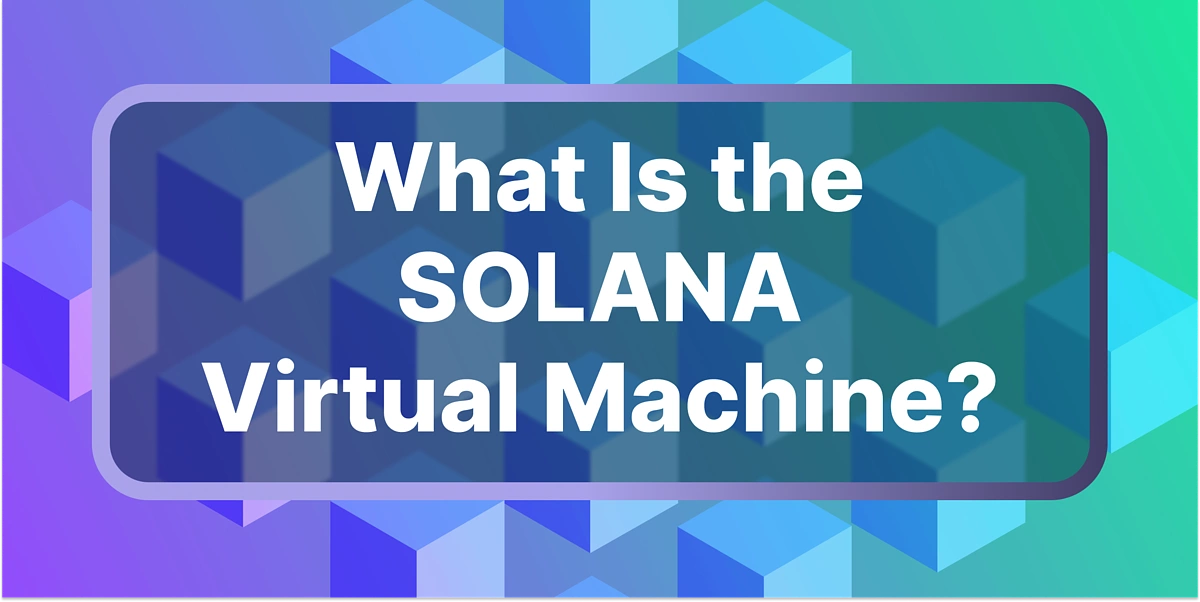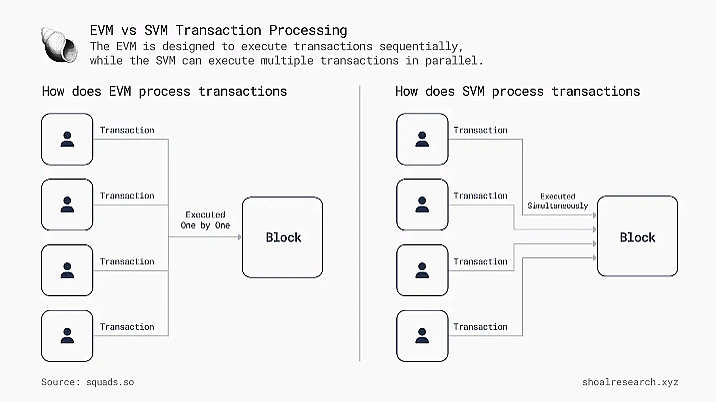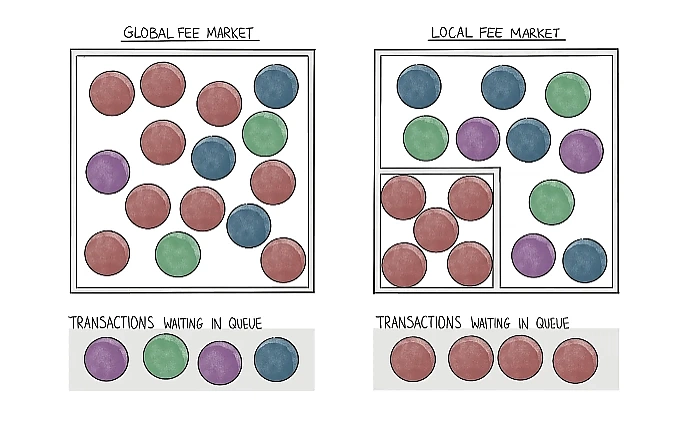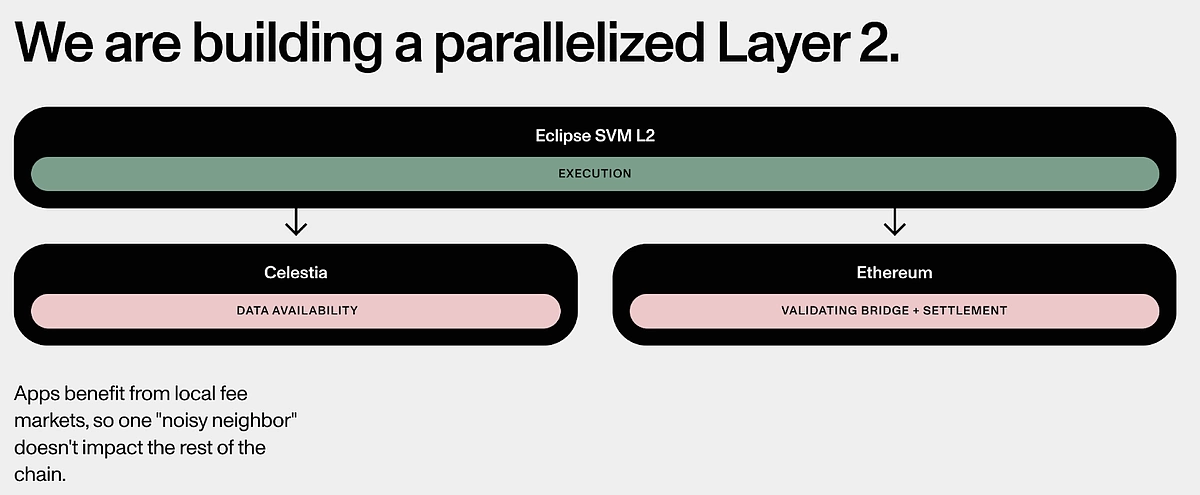 |
|
 |
|
 |
|
 |
|
 |
|
 |
|
 |
|
 |
|
 |
|
 |
|
 |
|
 |
|
 |
|
 |
|
 |
|
Solana 虚拟机(SVM)是 Solana 区块链上智能合约的执行环境,利用并行处理模型每秒处理数千笔交易,这使得基于 Solana 构建的 dApp 能够实现高吞吐量和低交易费用。 SVM 基于 Rust 编程语言运行,实现多线程事务处理模型,使网络上的验证器能够并发处理事务,从而提高效率和可扩展性。
What Is the Solana Virtual Machine (SVM)?
The Solana Virtual Machine (SVM) is the execution environment on the Solana blockchain, utilizing a parallel processing model for dApps that enables Solana to handle thousands of transactions per second.
什么是 Solana 虚拟机 (SVM)?Solana 虚拟机 (SVM) 是 Solana 区块链上的执行环境,利用 dApp 的并行处理模型,使 Solana 能够每秒处理数千笔交易。
Key Takeaways
The Solana Virtual Machine is the execution environment for smart contracts on the Solana blockchain. It enables the Solana blockchain to handle thousands of transactions per second.
要点 Solana 虚拟机是 Solana 区块链上智能合约的执行环境。它使 Solana 区块链能够每秒处理数千笔交易。
A virtual machine is a software emulation of a computer system that executes smart contracts within a secure environment.
虚拟机是计算机系统的软件模拟,可在安全环境中执行智能合约。
Solana VM is written in Rust programming language and runs a parallel processing model for applications. According to the developers, this enables greater performance and network capacity.
Solana VM 采用 Rust 编程语言编写,为应用程序运行并行处理模型。据开发人员称,这可以实现更高的性能和网络容量。
This article discusses how the Solana Virtual Machine works and other key features.
本文讨论 Solana 虚拟机的工作原理以及其他关键功能。

Smart contracts are a key part of the blockchain. Originally, blockchains were designed as a giant alternative payment network for one-way transactions between peers. With the creation of blockchain virtual machines (VM), it enabled smart contracts to be built on top of blockchains. From then on, the blockchain became a base layer upon which anything could be built.
智能合约是区块链的关键部分。最初,区块链被设计为一个巨大的替代支付网络,用于点对点之间的单向交易。随着区块链虚拟机(VM)的创建,智能合约能够构建在区块链之上。从那时起,区块链成为了可以构建任何东西的基础层。
Ethereum developed the first instance of a virtual machine for blockchain technology. The Ethereum Virtual Machine (EVM) has seen wide adoption, with popular Layer 1 blockchains such as BNB Smart Chain, Avalanche and Tron being built as a fork of the EVM, not to mention the many EVM-compatible Layer 2s being built today. Through the EVM, developers can easily port existing applications across EVM-compatible blockchains with minimal code changes.
以太坊开发了第一个用于区块链技术的虚拟机实例。以太坊虚拟机 (EVM) 已得到广泛采用,流行的第 1 层区块链(例如 BNB 智能链、Avalanche 和 Tron)被构建为 EVM 的分支,更不用说当今正在构建的许多与 EVM 兼容的第 2 层区块链。通过 EVM,开发人员可以轻松地将现有应用程序移植到 EVM 兼容的区块链上,只需进行最少的代码更改。
However, the Solana Virtual Machine (SVM), one of the newest prototypes of a virtual machine built to power smart contract blockchains, is emerging as a competitor. According to developers, Solana VM was built from scratch with technologies that focus on high performance and overall agility.
然而,Solana 虚拟机 (SVM) 作为为智能合约区块链提供支持的最新虚拟机原型之一,正在成为竞争对手。据开发人员介绍,Solana VM 是从头开始构建的,技术专注于高性能和整体敏捷性。
Understanding the Solana Virtual Machine (SVM)
The Solana Virtual Machine handles smart contract transactions for the Solana blockchain. Built with Rust programming language, the developers claim that the SVM is adjusted for high-demand conditions and designed to handle transactions in the most efficient way. As a virtual machine, the SVM operates as a virtualized processing machine tasked with the role of handling smart contract deployment, processing transactions, and other requests from these contracts.
了解 Solana 虚拟机 (SVM)Solana 虚拟机处理 Solana 区块链的智能合约交易。开发人员声称,SVM 采用 Rust 编程语言构建,针对高需求条件进行了调整,旨在以最有效的方式处理事务。作为虚拟机,SVM 作为虚拟化处理机运行,其任务是处理智能合约部署、处理交易以及来自这些合约的其他请求。
These transactions are state change requests, where the Solana VM computes requests and updates the overall state of the blockchain after each run. In summary, the SVM is the Solana blockchain’s execution environment. It acts in synergy with the consensus layer of the Solana blockchain to provide a dynamic network to build and run for Web3 applications.
这些事务是状态更改请求,Solana VM 计算请求并在每次运行后更新区块链的整体状态。综上所述,SVM 是 Solana 区块链的执行环境。它与 Solana 区块链的共识层协同作用,为 Web3 应用程序构建和运行提供动态网络。
The SVM supports diverse smart contract applications including GameFi, DeFi applications, and other decentralized applications. Like the EVM, Solana VM is a modular machine, where it can be deployed alongside other components, e.g. data availability / consensus layer, to build decentralized networks with little or no changes to its original form.
SVM支持多种智能合约应用,包括GameFi、DeFi应用和其他去中心化应用。与 EVM 一样,Solana VM 是一个模块化机器,可以与其他组件一起部署,例如数据可用性/共识层,用于构建去中心化网络,而对其原始形式几乎没有任何改变。
To better understand the Solana VM, let's take a look at what a Virtual Machine actually is.
为了更好地理解 Solana VM,我们来看看虚拟机到底是什么。
What Is a Virtual Machine?
Virtual machines (VMs) are a software emulation of the computer system, which can run an operating system, along with installing and executing applications. Traditionally, users ran a VM as sandbox environments that are fully isolated from their main computer operating system.
什么是虚拟机?虚拟机 (VM) 是计算机系统的软件模拟,可以运行操作系统以及安装和执行应用程序。传统上,用户将虚拟机作为沙盒环境运行,与主计算机操作系统完全隔离。
While traditional virtual machines are isolated sandboxes, blockchain virtual machines function as the execution layer of the network for decentralized applications. Blockchain VMs are decentralized, where nodes on the network run an instance of the blockchain’s virtual machine on their device, compute state changes, and monitor state changes suggested by other validators to achieve consensus, ensuring that the records of transactions are properly recorded on the network.
传统虚拟机是孤立的沙箱,而区块链虚拟机则充当去中心化应用程序网络的执行层。区块链虚拟机是去中心化的,网络上的节点在其设备上运行区块链虚拟机的实例,计算状态变化,并监视其他验证器建议的状态变化以达成共识,确保交易记录正确记录在网络上。
How the Solana Virtual Machine Works
Blockchain users are always looking for secure blockchain networks that allow them to perform transactions as fast as possible while paying the cheapest possible fees. The Solana VM was developed to satisfy the throughput desires of blockchain users and developers, while balancing the blockchain trilemma of decentralization, scalability, and security.
Solana 虚拟机的工作原理区块链用户一直在寻找安全的区块链网络,使他们能够尽可能快地执行交易,同时支付尽可能便宜的费用。 Solana VM 的开发是为了满足区块链用户和开发人员的吞吐量需求,同时平衡区块链去中心化、可扩展性和安全性的三难困境。
At the core of the Solana VM’s operation is the parallel transaction processing model. By structuring the Solana blockchain to process multiple transactions simultaneously instead of sequentially, it can offer higher throughput while enabling scalability.
Solana VM 操作的核心是并行事务处理模型。通过构建 Solana 区块链以同时而不是顺序处理多个交易,它可以提供更高的吞吐量,同时实现可扩展性。
Parallel Execution with SeaLevel
SeaLevel is one of the most vital components within the Solana VM, as it allows the virtual machine to execute transactions in parallel. In contrast to the sequential execution model, the parallel transaction processing model processes transactions simultaneously by validators across the network. This allows the network to achieve higher throughput and enhanced scalability.
SeaLevel 并行执行SeaLevel 是 Solana VM 中最重要的组件之一,因为它允许虚拟机并行执行事务。与顺序执行模型相反,并行事务处理模型由网络上的验证器同时处理事务。这使得网络能够实现更高的吞吐量和增强的可扩展性。

One of the challenges around parallel execution is when two transactions that change the state of the same account are executed at the same time, which could lead to errors in the final computation of the account.
并行执行面临的挑战之一是当两个改变同一账户状态的交易同时执行时,这可能会导致账户的最终计算出现错误。
For example, a wallet has a 0.5 SOL balance. There are two requests: a request to send 2 SOL to the account and a request to transfer 1 SOL from the account. If the transfer request is processed before the send request, errors can occur. Let’s look at how SeaLevel handles this situation.
例如,钱包有 0.5 SOL 余额。有两个请求:向账户发送 2 SOL 的请求和从账户转出 1 SOL 的请求。如果在发送请求之前处理传输请求,则可能会发生错误。让我们看看 SeaLevel 如何处理这种情况。
With Sea Level, the Solana blockchain is able to process tons of transactions using the multiple-thread execution environment. Solana contracts are designed to be explicit in their effects, where the smart contracts state which part of the blockchain’s state is modified by each transaction. This enables the state machine to discern dependent transactions from independent transactions. Independent transactions can run without conflict since they don’t affect the same account. In the case of dependent transactions that affect the same account, they are processed in sequence to avoid conflicts.
借助 Sea Level,Solana 区块链能够使用多线程执行环境处理大量交易。 Solana 合约的设计目的是明确其效果,其中智能合约说明每笔交易修改了区块链状态的哪一部分。这使得状态机能够区分相关事务和独立事务。独立交易可以在没有冲突的情况下运行,因为它们不影响同一个帐户。如果存在影响同一账户的相关交易,则按顺序处理这些交易以避免冲突。
The parallel transaction processing model allows the Solana blockchain to make maximum use of its resources, resulting in faster transaction processing and cheaper transaction fees. Moreover, to solve the issue of gas fee scalability faced by other virtual machines like the EVM, Solana blockchain operates a localized fee market.
并行交易处理模型使 Solana 区块链能够最大限度地利用其资源,从而实现更快的交易处理和更便宜的交易费用。此外,为了解决 EVM 等其他虚拟机面临的 Gas 费可扩展性问题,Solana 区块链运营着本地化的费用市场。
Localized Fee Market
In contrast to the global fee market, the localized fee market prevents a surge in activity from one smart contract from affecting the overall gas structure of the network.
本地化费用市场与全球费用市场不同,本地化费用市场可以防止智能合约的活动激增影响网络的整体 Gas 结构。

In global fee markets, the whole network jostles for the same processing facility. In a scenario where one smart contract experiences high demand, the whole network suffers from the high request frequency from this smart contract. This leads to situations where the overall network fee swells when a popular project experiences a spike in activity, for example during an NFT mint for a popular project.
来源:在全球费用市场中,整个网络都在争夺同一个处理设施。当一个智能合约的需求很高时,整个网络都会受到该智能合约的高请求频率的影响。这会导致当热门项目的活动激增时(例如,在热门项目的 NFT 铸币期间),整体网络费用会激增。
To prevent this, Solana network implements a localized fee market. With this, each smart contract on the network operates a separate processing charge structure. In case of a spike in activity, transactions from the smart contract experience a spike in gas while the rest of the network still operates on the normal gas fee rate. This limits the impact of spikes in activity from related smart contract application(s), while the rest of the network remains largely unaffected.
为了防止这种情况,Solana 网络实施了本地化费用市场。这样,网络上的每个智能合约都运行一个单独的处理费用结构。如果活动激增,来自智能合约的交易会经历 Gas 激增,而网络的其余部分仍按正常 Gas 费率运行。这限制了相关智能合约应用程序活动高峰的影响,而网络的其余部分基本上不受影响。
However during peak demand periods, where all dApps on the network are experiencing high activity, it still increases competition for remaining blockspace, and results in higher gas fees.
然而,在需求高峰期,网络上的所有 dApp 都处于高活动状态,这仍然会增加对剩余区块空间的竞争,并导致更高的 Gas 费。
Rollup Projects Using the SVM
Due to the high performance of the Solana VM, some rollup projects are choosing the SVM for execution, while retaining the security and decentralization of the main network. Here are some rollup networks using the Solana Virtual Machine.
使用SVMD的Rollup项目由于Solana VM的高性能,一些Rollup项目选择SVM来执行,同时保留主网络的安全性和去中心化性。以下是一些使用 Solana 虚拟机的汇总网络。
Eclipse

蚀
Eclipse is an EVM-compatible Layer 2 zero knowledge network built using the Solana VM. According to the project, adopting the Solana VM model to build an extremely fast rollup and settling transactions on the Ethereum network enables them to combine the best of both worlds. While the Solana VM is able to process transactions faster than the EVM, Ethereum is known to be one of the most secure and decentralized smart contract networks. Therefore, Eclipse is able to achieve an improved speed compared to other EVM Ethereum rollup networks, while maintaining Ethereum-level security and decentralization.
Eclipse 是使用 Solana VM 构建的与 EVM 兼容的第 2 层零知识网络。根据该项目,采用 Solana VM 模型在以太坊网络上构建极快的汇总和结算交易使他们能够结合两个世界的优点。虽然 Solana VM 能够比 EVM 更快地处理交易,但以太坊被认为是最安全和去中心化的智能合约网络之一。因此,与其他 EVM 以太坊 Rollup 网络相比,Eclipse 能够实现更高的速度,同时保持以太坊级别的安全性和去中心化。
Eclipse uses Celestia for its Data Availability (DA) layer. With Celestia, it aims to develop a stable network for the transfer of data between its execution environment and the Ethereum consensus system. It also uses RISC zero for its Zero knowledge proof computation. Using a ZK validity proof system, Eclipse hopes to achieve immediate verification for its transaction data on the mainnet. This eliminates the need for an extra fraud-proof system and a waiting interval for mainnet validation, as in the case of optimistic rollups.
Eclipse 使用 Celestia 作为其数据可用性 (DA) 层。 Celestia 的目标是开发一个稳定的网络,用于在其执行环境和以太坊共识系统之间传输数据。它还使用 RISC 零进行零知识证明计算。 Eclipse希望通过ZK有效性证明系统实现其主网上交易数据的即时验证。这消除了对额外防欺诈系统和主网验证等待间隔的需要,就像乐观汇总的情况一样。
At the time of writing, Eclipse is yet to launch publicly. According to a recent announcement from the Eclipse Foundation, the project has raised a total of $65 million to advance its efforts in building an SVM L2 for the Ethereum blockchain.
截至撰写本文时,Eclipse 尚未公开发布。根据 Eclipse 基金会最近发布的公告,该项目已筹集总计 6500 万美元,用于推进为以太坊区块链构建 SVM L2 的工作。
MakerDAO
The MakerDAO community is on the verge of transition to a new chain for the complete reimplementation of the entire Maker Protocol built natively on a new, standalone blockchain.
MakerDAO MakerDAO 社区即将过渡到新链,以完全重新实现在新的独立区块链上原生构建的整个 Maker 协议。
While this is still in the community governance phase, a little information is already accessible. This includes MakerDAO co-founder Rune Christensen's preference for the Solana codebase as the prototype for the project’s new chain. In a proposal presented to the community by Rune, he cited the Solana blockchain’s resilience amidst the FTX exchange collapse and its optimization for the purpose of operating a singular, highly efficient blockchain as his major reason for picking the network’s codebase as his top choice.
虽然这仍处于社区治理阶段,但已经可以获得一些信息。这包括 MakerDAO 联合创始人 Rune Christensen 对 Solana 代码库作为该项目新链原型的偏好。在 Rune 向社区提交的提案中,他引用了 Solana 区块链在 FTX 交易所崩溃中的恢复能力以及为运营单一、高效的区块链而进行的优化,这是他选择该网络代码库作为首选的主要原因。
Based on the community post, Cosmos is the other main contender, with its history of successful appchains using the Cosmos stack. However, he highlights that “Cosmos is not built around efficiency at its core in the same way Solana is which means it would cost more to maintain and keep performant.”
根据社区帖子,Cosmos 是另一个主要竞争者,它拥有使用 Cosmos 堆栈的成功应用链的历史。不过,他强调,“Cosmos 并不像 Solana 那样以效率为核心,这意味着维护和保持性能的成本会更高。”
If the project finally decides to adopt the Solana network codebase as the standard for its NewChain, this will serve as a bold statement of the positive impression the Solana VM have made on blockchain projects. Reiterating his preference for the Solana Codebase, Rune mentioned that developing a blockchain network with the Solana codebase will enable Maker to benefit from the resilience of the Solana blockchain and its community. Also, MakerDAO will be able to access a large pool of developers and resources to enable it to grow faster. The network will also create a communication path with the Solana network using bridges. Read the full proposal and discussion here.
如果该项目最终决定采用 Solana 网络代码库作为其 NewChain 的标准,这将是 Solana VM 给区块链项目带来的积极印象的大胆声明。 Rune 重申了他对 Solana 代码库的偏好,并提到使用 Solana 代码库开发区块链网络将使 Maker 能够从 Solana 区块链及其社区的弹性中受益。此外,MakerDAO 将能够获得大量的开发人员和资源,使其能够更快地发展。该网络还将使用网桥创建与 Solana 网络的通信路径。请在此处阅读完整的提案和讨论。
SVM vs. EVM
Solana network is creating a path for itself with the Solana VM. As the SVM ecosystem grows, it will compete with the much older EVM in terms of relevance and adoption. SVM and EVM are able to handle smart contract transactions for blockchain networks. Like the EVM, the SVM is gaining application on other blockchain networks apart from the Solana Network. Here, we take a look at some of their key differences.
SVM 与 EVMSolana 网络正在使用 Solana VM 为自身创建一条路径。随着 SVM 生态系统的发展,它将在相关性和采用方面与更古老的 EVM 竞争。 SVM 和 EVM 能够处理区块链网络的智能合约交易。与 EVM 一样,SVM 正在 Solana 网络之外的其他区块链网络上获得应用。在这里,我们来看看它们的一些主要区别。
Programming Language: Rust vs. Solidity
The Solidity programming language was developed specifically for the EVM. It is an adaptation of the JavaScript programming language and is designed for ease of learning. Like JavaScript and many other high-level programming languages, Solidity is object-oriented, where variables are declared using objects and classes. As a programming language for smart contracts and the EVM, Solidity is designed with a focus on security.
编程语言:Rust 与 Solidity Solidity 编程语言是专门为 EVM 开发的。它是 JavaScript 编程语言的改编版本,旨在易于学习。与 JavaScript 和许多其他高级编程语言一样,Solidity 是面向对象的,其中变量是使用对象和类声明的。作为智能合约和 EVM 的编程语言,Solidity 的设计重点是安全性。
In comparison, Rust is a general programming language. It can be used for smart contracts and other applications. While Rust is harder to learn, it is known for its agility and memory efficiency, along with its reputation for facilitating high performance and concurrency, which aligns with Solana’s focus on scalability.
相比之下,Rust 是一种通用编程语言。它可用于智能合约和其他应用程序。虽然 Rust 更难学习,但它以其敏捷性和内存效率而闻名,并以促进高性能和并发性而闻名,这与 Solana 对可扩展性的关注是一致的。
Transaction Processing Model: Parallel vs. Sequential Processing
SVM is a multi-thread transaction processing environment. It makes extensive use of the resources available on the network to process transactions. Multiple transactions are executed concurrently across different validator cores and transaction proofs are submitted for consensus as the network attains a uniform state after each run. As outlined above, Solana SeaLevel ensures that the network avoids the complications of parallel processing while running this execution model.
事务处理模型:并行处理与顺序处理SVM 是一个多线程事务处理环境。它广泛利用网络上可用的资源来处理交易。多个交易在不同的验证器核心上同时执行,并且当网络在每次运行后达到统一状态时,提交交易证明以达成共识。如上所述,Solana SeaLevel 确保网络在运行此执行模型时避免并行处理的复杂性。
Conversely, the EVM processes transactions in sequence. Multiple transactions are queued and processed one after the other. The network validates transactions using one validator core at a time. Parallel processing has shown a significantly higher throughput than sequential transaction processing models. According to reported data, the Solana blockchain can process thousands of transactions per second – this is higher than the reported speed of the Ethereum blockchain and other instances of the EVM like L2 networks and POS sidechains.
相反,EVM 按顺序处理交易。多个事务依次排队并处理。网络一次使用一个验证器核心来验证交易。并行处理的吞吐量明显高于顺序事务处理模型。根据报告的数据,Solana 区块链每秒可以处理数千笔交易,这高于以太坊区块链和其他 EVM 实例(如 L2 网络和 POS 侧链)的报告速度。
Efficiency: TPS vs. Transaction Fee
From information obtained from official network explorers, the Solana network has a transaction speed of over 2400 TPs, and transaction fees are as low as $0.001. Compared to EVM networks like Base Network with a transaction speed of about 47 TPS and a transaction fee of about $0.03, the Solana network shows a significantly higher cost and time efficiency. While this could be subject to network conditions, the Solana network can also scale to over 60,000 TPS. After the implementation of EIP-4844, Base Network’s $0.03 transaction fee is an improvement on the transaction fee on the mainnet blockchain, however, it is still short of the cost-efficiency of the Solana blockchain
效率:TPS vs. 交易费用从官方网络浏览器获得的信息显示,Solana 网络的交易速度超过 2400 TP,交易费用低至 0.001 美元。与 Base Network 等 EVM 网络的交易速度约为 47 TPS、交易费用约为 0.03 美元相比,Solana 网络表现出明显更高的成本和时间效率。虽然这可能会受到网络条件的影响,但 Solana 网络也可以扩展到超过 60,000 TPS。 EIP-4844实施后,Base Network的0.03美元交易费用相对于主网区块链的交易费用有所改善,但仍低于Solana区块链的成本效率
Summary of SVM vs. EVM
SVM 与 EVM 的总结 | Solana VM (SVM) Solana 虚拟机 (SVM) | Ethereum VM (EVM) 以太坊虚拟机(EVM) |
Transaction processing 事务处理 | Multi-thread transaction processing environment 多线程事务处理环境 | Single-thread transaction processing environment 单线程事务处理环境 |
Data Handling 数据处理 | Solana smart contracts describe all the states a transaction will read or write while executing Solana 智能合约描述了事务在执行时将读取或写入的所有状态 | Transactions are executed in sequence, eliminating the need to declare states before execution 交易按顺序执行,无需在执行前声明状态 |
Programing language 编程语言 | Rust, C++ 铁锈、C++ | Solidity, Vyper, JavaScript Solidity、Vyper、JavaScript |
Efficiency 效率 | Process transactions faster 更快地处理交易 | Relatively slower due to its single-thread model 由于其单线程模型,速度相对较慢 |
Adoption 采用 | Solana, Nitro, Eclipse Solana、硝基、Eclipse | Used by numerous sidechains, L1s, and L2 networks 被众多侧链、L1 和 L2 网络使用 |
Fee Market 费用市场 | Global and Localized fee market 全球和本地化费用市场 | Global Fee Market 全球费用市场 |
Final Thoughts
The Solana Virtual Machine prioritizes high throughput; a feature sought after by a big section of blockchain developers. It was built to deliver at speed and cost less than most other processing machines, which contributes immensely to the overall popularity of the Solana blockchain.
最后的想法 Solana 虚拟机优先考虑高吞吐量;这一功能受到大部分区块链开发人员的追捧。它的设计速度比大多数其他处理机器更快且成本更低,这极大地促进了 Solana 区块链的整体普及。
With the Solana network now achieving success and adoption, we are seeing early adoption of the Solana VM by other projects, similar to the earlier path taken by EVM. These projects are either building directly on what has been achieved by the Solana network, or creating their own stack using other modular components.
随着 Solana 网络现已取得成功并得到采用,我们看到其他项目早期采用了 Solana VM,类似于 EVM 早期采用的路径。这些项目要么直接构建在 Solana 网络已实现的基础上,要么使用其他模块化组件创建自己的堆栈。
This article attempts to give readers an understanding of what the Solana VM actually is and how it works. However, it is not exhaustive of every aspect of the Solana VM and its associated projects. Having said this, note that this article is only for educational purposes and is not financial advice. Featured projects are not endorsed, and users should always do their own research before investing in any cryptocurrency.
本文试图让读者了解 Solana VM 的实际含义及其工作原理。但是,它并未详尽介绍 Solana VM 及其相关项目的各个方面。话虽如此,请注意本文仅用于教育目的,并非财务建议。特色项目不受认可,用户在投资任何加密货币之前应始终进行自己的研究。

Joel is deeply interested in the technologies behind cryptocurrencies and blockchain networks. In his over 7 years of involvement in the space, he helps startups build a stronger internet presence through written content. He is the founder of CryptocurrencyScripts.Follow the author on Twitter @agboifesinachi
CoinGecko 的内容编辑指南CoinGecko 的内容旨在揭开加密货币行业的神秘面纱。虽然您看到的某些帖子可能受到赞助,但我们努力维护编辑质量和诚信的最高标准,并且不会发布任何未经我们编辑审查的内容。了解更多告诉我们您有多喜欢这篇文章!Joel AgboJoel 深感对加密货币和区块链网络背后的技术感兴趣。在他涉足该领域 7 年多的时间里,他帮助初创公司通过书面内容建立更强大的互联网影响力。他是 CryptocurrencyScripts 的创始人。在 Twitter 上关注作者@agboifesinachi
阅读乔尔·阿格博的更多内容
免责声明:info@kdj.com
所提供的信息并非交易建议。根据本文提供的信息进行的任何投资,kdj.com不承担任何责任。加密货币具有高波动性,强烈建议您深入研究后,谨慎投资!
如您认为本网站上使用的内容侵犯了您的版权,请立即联系我们(info@kdj.com),我们将及时删除。
-

- Dogecoin,比特币ETF,以太ETF:骑加密波
- 2025-09-18 08:00:58
- Dogecoin的嗡嗡声,比特币ETF的统治地位以及Ether ETF的潜力 - 用纽约人的优势驱逐加密景观。
-

- 加密投资者眼球链链:预售有望高ROI
- 2025-09-18 08:00:00
- 加密投资者正在寻找下一件大事,而BlockChainFX($ bfx)正在以其雄心勃勃的生态系统和预售津贴吸引着眼睛。
-

-

- BITTENSOR,DTAO和AI暴露:使AI革命的访问民主化
- 2025-09-18 07:49:46
- 探索Bittensor的DTAO如何为散户投资者AI的风险提供与独家AI公司和动荡的模因硬币形成鲜明对比。
-

- Bullzilla:Meme Coin Royalty还是加密投资策略?
- 2025-09-18 07:49:24
- 使用Bullzilla:2025年加密投资的动态策略来导航Meme Coin市场。
-

- 加密至5000美元:发掘2025年的模因象征性月亮和稳定的投资
- 2025-09-18 07:45:00
- 从模因令牌到以太坊的稳定性,将加密货币景观导航。在2025年发现潜在的100倍收益和长期发挥。
-

- 比特币的平衡法:美联储削减率和关键支持水平
- 2025-09-18 07:44:51
- 分析比特币对美联储降低税率,关键支持水平和潜在市场变动的反应。
-

- 区块链分析,风险管理和银行监管机构:监督的新时代
- 2025-09-18 07:31:54
- NYDFS对区块链分析的推动标志着一个转折点。银行现在必须采用加密货币,保护非法财务并适应不断发展的风险。
-






























































